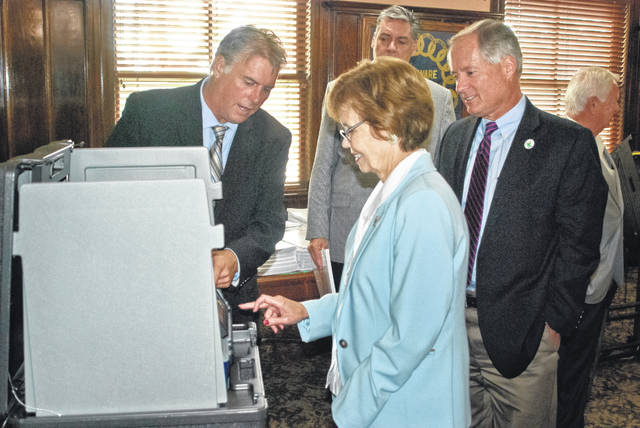
The Delaware County Board of Elections and the Delaware County Board of Commissioners are working together to give residents the best voting experience possible.
“We feel we’ve done our due diligence,” Board of Elections Chairman Ed Helvey told commissioners during a special work session held Aug. 20 to weigh the options the county has when it comes to purchasing new voting machines. “We’ve looked at all the different systems and this will provide not only a good election experience, but the type of election experience that the citizens in Delaware County have come to expect.”
In June, both the Ohio House of Representatives and Ohio Senate passed Senate Bill 135, sponsored by State Sen. Frank LaRose (R-Hudson). The bill will afford the secretary of state the authority to request up to a total of $114.5 million in state funds for the reimbursement to individual boards for the purchase of voting machines. The bill becomes effective Oct. 29.
“Well over a year ago, meeting in our office, we invited all the counties in central Ohio … with the thought that if there was commonality we could come to a decision that would create synergy,” Helvey said. “That makes a really good cluster of the counties within proximity to us.”
Helvey said in those meetings with other central Ohio counties, vendors of voting equipment were brought in to conduct demonstrations. He said that several of the counties have shown an interest in RBM Consulting, an election service provider.
Board of Elections Director Karla Herron said RBM is offering two models for election voting. The first is a hybrid that uses a select touchscreen that produces a paper ballot after voting for the voter to look over. Once the voter confirms the ballot is correct, he or she feeds the ballot into a tabulation machine where the information is recorded onto a thumb drive along with an image of the ballot.
In the case of a recount, “you do recounts from watching it on a TV monitor,” said Jay Perbix, RBM Consulting election consultant.
Herron said that the board of elections would purchase 800 voting machines and 200 tabulation machines, which would come in close to $4 million. She said the state would provide almost $2 million for the purchase of the equipment, and the county would be responsible for the difference.
“We think that what the state will provide and what we have generated for the county will cover this (type of machine),” Helvey said.
Herron said that the other option is to take a step back to using paper ballots where the bubbles are filled in as the voter makes their choices. The cost to print the paper ballots for each election would cost $6,000 to $7,000 over the lifetime of the system.
“You can’t get away from paper completely because of absentee and provisional ballots,” Herron said. “The challenge with our board is a recount. We’ve never seen, with an electronic vote system, a vote change. It’s always inconsistent with paper. Everyone in this business will tell you that a paper count is very difficult to get the same answer twice.”
“Minimizing uncertainty is so important,” said Commissioner Barb Lewis.
According to prior reports by the board of elections, Delaware County has 139,020 registered voters and 159 precincts in about 50 polling locations. On one of the tables in the commissioners meeting room, the board of elections stacked three precincts of ballots.
“This is enough ballots for a primary, three precincts, that is kind of concerning for our poll workers,” said Anthony Saadey, board of elections deputy director. “If we’re to go back to paper, we would have to rework our entire polling location system.”
Saadey said that Mahoning County had gone back to paper ballots, and he heard they were regretting the move from the electronic machines.
“Delaware County is going to be getting just a little under $2 million as our portion,” Saadey said. “I asked what that would buy us. It was going back to a manual (paper) ballot.”
Lewis asked Herron how long it took to close each machine on election night and get the results back to the board office.
“It takes us 15 minutes a machine,” Herron told the commissioner. “We’ve got it down to about two hours for the board’s largest locations.”
Perbix said with the electronic machine that RBM was suggesting it would take about five minutes to close a machine.
However, “Five minutes would be a stretch, probably more like three minutes,” he said. “From the standpoint of how much quicker you should get your results is all about them getting back … it roughly takes three seconds once you plug that thumb drive in that you’ll have your results.”
Since the Aug. 20 meeting was just a work session, no decision was made by the commissioners whether or not to spend the necessary money needed to cover the new voting machines or to go back to using paper ballots.


